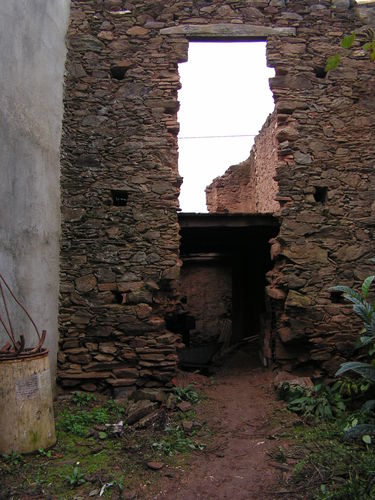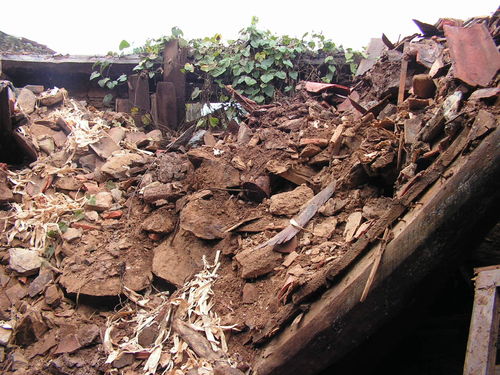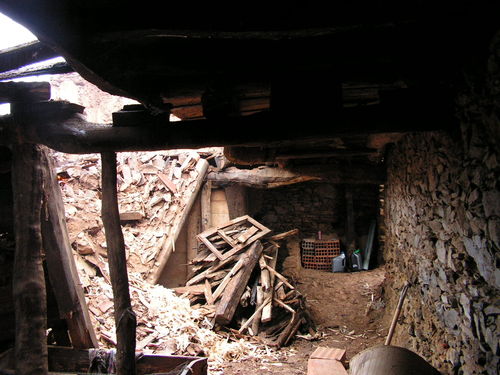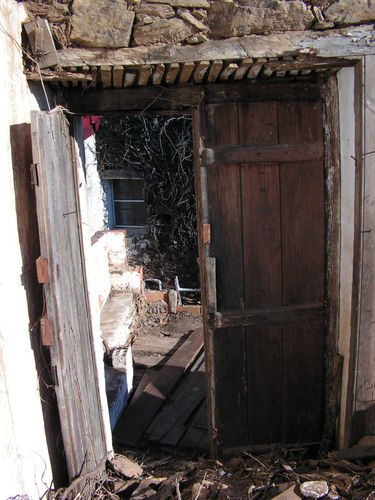|
The more you dig down into the history of Portuguese building methods, the more respect you get for these craftsmen that made the dry stone walls. I’m not totally inexperienced in the matter. I’ve learned the process of looking for the stone’s face, how to stack them and fill the gabs in between, from a Turkish friend during my stay over there. We did get the all the wood out, and cleaned out most of the space. Just one corner was still filled with stones and dirt. We just didn’t find the energy at that time…. I couldn’t wait to start rebuilding but first we had to clean out the ruin totally. The pile of stones got higher and wider in the back garden and together with the clay that was used render the walls it became a solid “mountain”. That’s where the solution was. flattening out that steep sloping garden by making terraces. It ment making a strong wall between the raised up garden and the neighboring property. Now, there’s only a few pictures to show the work but it took another 3 months. hen I’m talking about “we”, I mean myself and my lovely wife who worked “like a man” making concrete, moving big pieces of rock etc. Now, there shouldn’t be a winter in Portugal, (that’s what they say in the tourism brochures) but we had 3 months of rainstorms…. The now exposed back wall collapsed with a big rumble in the middle of a December night. More cleaning up to do, more to rebuild. The ruin had a little side building, witch we left untouched up until then, but with having a way to go through the building and a place to stock the stones, made us decide to clean that out to, before starting with any rebuilding. Still no woodworking involved….. but you have to got endurance and determination to get a nice workshop.
next time; slowly working towards the first stone of rebuilding.
0 Comments
And there he was, our friend from the Netherlands to help us out. Just for a week or so. Soon we found out that it’s a big advantage to be 22, big and strong. Did we had thought of making a hole in the wall to get everything to the back yard? Yes, we did, but making a hole, where you can go through with a wheel barrel, into a 70 cm thick wall of stones, made us thinking about it, thinking! It must have been about 6 hours later, and there it was, our future door opening all the way up to the beam of the second floor window. eWith the unstable second floor half hanging on the wall, supported with some beams, we started to take out as many wood as we could. 95% was just good enough to keep us warm that winter, the rest was cleaned, de-nailed (is that an English word?) and cut into movable lengths. After a week of hard work, 3 chains and 25 liters of fuel for the chainsaw, the project started to show some progress. Down point however was the pile of stones in the garden… we had to do something with it. We couldn’t get it out of there, (the garden is on top of a hill, 60 meters up, and our neighbors wouldn’t have liked us throwing everything down the hill. The olive trees are sacred so any damage would get us in to real trouble. next time: more stone, rock and dirt.
After the dust was gone we could see what we bought. It’s strange to realize that just a decade ago, somebody lived in this building. No water, no toilet, no electricity. It must have been a simple and poor life for the old lady that spend her last years in this, what used to be the main house of a farm. As a woodworker, tears get in to your eyes, seeing that the former owner didn’t clean out the property before putting it down. The big stone wall went half thru the floor, leaving a very unstable situation. A single steel bed in one corner, some 100 year old drawers smashed by big pieces of rock, every piece of wood completely eaten from the inside out by longhorn beetles. It became a journey in to the history of this former grand building. 3 garbage bags full of medicines, x-ray pictures and medical reports, it must have been a worrying life. It makes you realize how complicated we made our lives as you find 2 plates, 2 knifes, 2 forks, 2 spoons some pots and pans and a candle holder. Here and there little details remained, wooden doors that open without hinges, some catholic relics, some old tools and doorknobs. The village we’re living in goes back to the times of the Templar knights, who had their headquarters at the Convento do Cristo in Tomar. Being surrounded by 70 cm thick walls, just stacked out of rocks and slate make your mind wandering of to medieval times.
The first thing to do was get that floor empty by starting to take out all the wood. No, not much could be saved. Most of it ended in the wood-burner and it kept us warm for 2 winters. Luckily the 2 big beams that supported al the others are walnut and survived the 200 years well. We decided to keep them in, although it meant that the ceiling on the ground-floor would be low. After a few weeks of clearing out the top part, by throwing every thing over a 6 meter high wall in to the back garden, we got to realize that it would take ages to get all this heavy work done. While the wood could shortened by a chainsaw, the story on handling the pieces of rock is a different one. Trying to move 60 or 70 kilograms without any help seemed to be impossible. There were day’s we managed only 2 or 3. Just at the point of getting desperate, a call from The Netherlands was going to make a difference….. next time; Helping hands |
Follow us on
Instagram! Categories
All
Looking Back
November 2017
|



























 RSS Feed
RSS Feed
